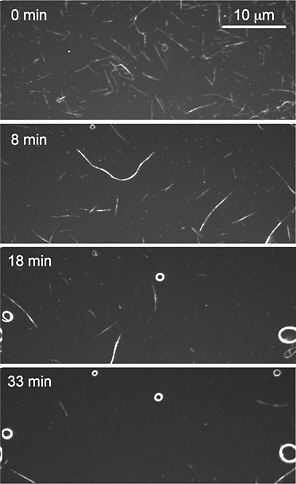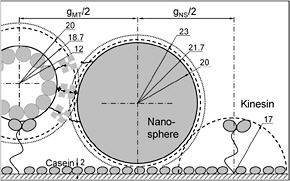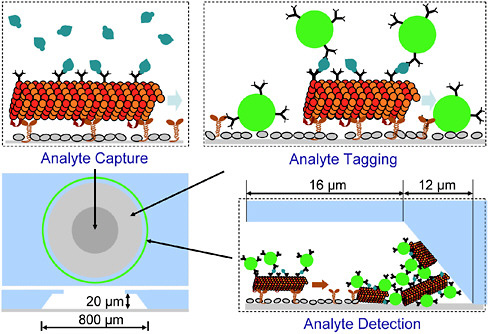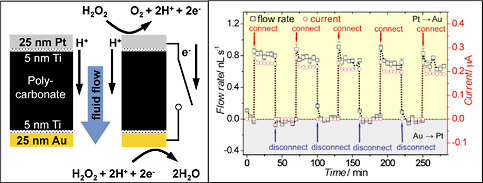Autonomous Systems and Synthetic Biology
HENRY HESS
Columbia University
Autonomous systems have helped solve a variety of engineering challenges, from drastic changes in manufacturing processes since the 1950s to the exploration of space and oceans. Recently, autonomous systems conceived at the micro- and nanoscale levels are being used to address challenges in materials and biomedical applications. These microscopic devices and their applications are inspired by autonomous biological systems that operate both individually and collectively.
A prototypical autonomous biological device is a Vibrio cholerae bacterium that packs the ability to move, sense, target, adapt, and release active substances into just a few cubic centimeters. An example of a smart biological material, muscle, which is composed of autonomous systems, is hierarchically assembled from microscopic subunits, has the ability to exchange information with the environment via electrical and mechanical stimuli, and incorporates energy-conversion modules and self-healing abilities.
Both V. cholerae bacteria and muscle cells are significant achievements in engineering by evolution. Both can operate in diverse environments with low power consumption and limited computing resources.
These and other examples of microscopic systems with complex functionalities have been the inspiration for the emerging field of synthetic biology. A prominent research strategy in this new field—inspired by the successful large-scale integration of electronic circuits—is to focus on the design of standardized gene circuits that can serve as modules of complex programs to be executed by bacterial cells. This approach is akin to the delivery of a set of well organized blueprints to a contract manufacturer who then manufactures equipment according to the delivered specifications, learns from the experience of technicians to operate the equipment, and produces a product of interest.
A second strategy, which is the topic of this paper, is to develop the technical expertise to rationally design complex, interacting microscopic systems (Schwille and Diez, 2009). This approach builds on nanotechnology, as well as on increasingly complex in vitro experiments in cell biology. In these experiments, we replicate critical cellular functions to test our understanding of essential and auxiliary biological mechanisms and components.
The challenges in designing biomimetic systems using nanoscale building blocks include (1) controlling their operation in the presence of Brownian motion and other sources of noise, (2) integrating molecular information properly, (3) addressing lifetime and reliability issues, and (4) anticipating and using emergent phenomena.
KINESIN-POWERED MOLECULAR SHUTTLES
Kinesin motors are proteins that use ATP molecules as fuel to generate mechanical work (Howard, 2001). A microtubule assembled from thousands of tubulin proteins serves as a track for the kinesin motor. For each ATP molecule a kinesin motor hydrolyzes, it takes one step (i.e., moves 8 nanometers [nm]) along the microtubule track. The kinesin motor can advance against a force of about 5 piconewtons (pN), in the process converting more than 50 percent of the free energy of ATP hydrolysis into mechanical work.
Within cells, kinesin is primarily responsible for transporting molecular cargo from the center of the cell to the periphery. Biophysicists have developed the ability to observe and manipulate kinesin motors and the associated microtubule filaments outside the cell in so-called in vitro gliding assays. In these assays, kinesins are adhered to a surface, and fluorescently labeled microtubules are propelled by kinesin motors in the presence of ATP (Figure 1).
In addition to enabling the study of motor proteins, microtubules propelled by kinesin motors serve as a nanoscale transport system. By controlling the direction of the microtubules, the attachment and detachment of cargo to microtubules, and the supply of ATP fuel, microtubules can be induced to act as nanoscale delivery trucks, or “molecular shuttles” (Hess and Vogel, 2001). Assembled from biological components with unmatched functionality, these molecular shuttles can be used to explore design concepts for nanoscale systems and devices (Hess et al., 2002a,b).
Although individual molecular shuttles can be controlled (van den Heuvel et al., 2006), the inherent advantages of molecular devices can be better exploited by putting aside costly efforts to achieve individual control and accepting instead the autonomous operation of molecular shuttles in an externally directed “swarm.”
A suitable analogy to this scenario is an anthill. Although in principle it is possible to induce an individual ant to perform a specific task, the anthill, as a complex system, relies on the emergence of useful actions that result from the autonomous

FIGURE 1 Surface-adhered kinesin motors can propel fluorescently labeled microtubules (diameter 25 nm) across a surface. A coating of casein proteins on the surface prevents the kinesin motor domains from attaching to the surface. The experiment is conducted in a cell composed of a cover slip, spacers, and a slide. When microtubule motion is observed with a fluorescence microscope, microtubules appear as fluorescent rods, and the kinesin motors on the surface are invisible.
decisions of individual ants. Figure 2 shows the assembly of “nanospools” from “sticky” microtubules, a striking example of emergence in swarms of molecular shuttles (Hess et al., 2005).
MECHANICAL ENGINEERING AT THE INTERFACE OF BIOPHYSICS AND SUPRAMOLECULAR CHEMISTRY
Precise measurements of nanometer lengths and molecular arrangements and interactions are the building blocks for the rational engineering of molecular shuttles. For example, fluorescence-interference contrast microscopy enables the measurement of the 20 nm “ground clearance” of molecular shuttles (Kerssemakers et al., 2009). Other experiments have determined the distribution of cargo-binding linker molecules on the shuttles and elucidated the complex, glue-like interaction between complementary linker molecules on a shuttle and its cargo (Pincet and Husson, 2005).
The combination of precise spatial information and detailed knowledge of molecular interactions enables us to predict emerging properties, such as an optimal velocity for cargo loading (Agarwal et al., 2009). This optimal velocity is a result of (1) the milliseconds required for the glue-like interaction between biotin and streptavidin to strengthen and (2) the velocity-dependence of the number of attempts to form such bonds.
The importance of such studies is that they transition from the reductionist analysis of molecular processes often practiced in biophysics and supramolecular chemistry to an engineering analysis of emerging phenomena resulting from

FIGURE 2 Biotin-functionalized microtubules rendered “sticky” by a partial coating of streptavidin self-assemble into nanowires and ultimately into nanospools.
the assembly of well understood building blocks into complex and artificial structures.
The challenge is made more daunting because classic engineering tools, such as technical drawings, have not yet been adapted to capture the dynamic nature of molecular structures. Questions such as whether the fluctuating reach of a linker molecule should be represented by its most likely or it most extended configuration (or both) are very important in a complex technical drawing (Figure 3) showing molecules of different sizes and flexibilities interacting on a wide range of time scales.

FIGURE 3 Understanding the interaction between a gliding microtubule functionalized with linker molecules (left) and a surface-adhered nanosphere coated with the complementary molecules requires a detailed analysis of the spatial arrangement. Lengths are measured in nanometers, dashed lines represent most likely positions, and dotted lines represent maximal extensions of biotin linkers and kinesin molecules. Adapted from Agarwal et al., 2009.
“SMART DUST” BIOSENSORS AS APPLICATIONS OF MOLECULAR SHUTTLES
Microorganisms, which have the ability to detect a variety of analytes with high specificity and sensitivity, process the incoming information, and communicate their measurements, excel at biosensing. From the perspective of an engineer, microorganisms act as microscopic sensor packages that are immersed into the sample (their environment) and collectively respond to analytes.
This concept is transferred to the engineering domain by “smart dust,” which is an attempt to create highly integrated microscopic sensors in large numbers for remote detection scenarios (Kahn et al., 2000; Sailor and Link, 2005). With support from the DARPA Biomolecular Motors Program, five research teams working collaboratively pursued the creation of “smart dust” biosensors, whose core components are molecular shuttles (Bachand et al., 2009). In these sensors, antibody-functionalized molecular shuttles capture analytes, tag them with fluorescent particles, and transport them to a deposition zone for detection (Figure 4).
This design has several “biomimetic” aspects. First, the concept of smart dust per se is inspired by biological organisms. Second, the components of the molecular shuttles—kinesin motors, microtubules, and antibodies—are biological in origin. And third, the principle of operation, a swarm of unsophisticated, autonomous devices creating a detectable signal, is also bio-inspired.
The disadvantages of such a hybrid device are also closely related to its biological origins. Although maintaining the biological components in a relatively

FIGURE 4 A “smart dust” biosensor based on molecular shuttles. Antibody-functionalized microtubules capture analyte molecules, such as protein biomarkers, in the center of a circular well and transport them across the surface. Collisions with antibody-coated fluorescent particles leads to particle capture if analyte is present. Eventually, shuttles reach the periphery of the well, where they accumulate and their cargo of analytes and fluorescent particles can be detected optically.
narrow temperature range at a given pH and with well defined buffer conditions is feasible in the laboratory, it cannot be guaranteed in the field. Therefore, although strategies for extending the lifetime and optimizing storage conditions have been explored (Boal et al., 2006; Seetharam et al., 2006), the fragility of the biological components is a key shortcoming. Successful proof-of-principle demonstrations of application concepts with hybrid devices will therefore require the development of synthetic components, such as synthetic molecular motors (Kay et al., 2007).
However, even when synthetic devices come close to achieving the performance of their natural counterparts, there is still an open question about whether there will be a fundamental trade-off between robustness and performance that will lead to similarly fragile synthetic devices. In addition, we do not know if biomolecular motors represent the pinnacle of achievable performance in terms of force, power, and energy efficiency, or if the use of synthetic materials and fabrication techniques will result in dramatic improvements in one or more metrics.
TRANSITIONING TO SYNTHETIC MATERIALS
In addition to the exciting research and potential applications of hybrid systems mentioned above, the performance and capabilities of synthetic systems are being steadily improved by ongoing efforts in the semiconductor industry to miniaturize energy sources, sensors, computing elements, and communications systems. This technological trend may enable the design of “nanomorphic cells” (Cavin and Zhirnov, 2008). The creation of entirely new classes of autonomous micro-devices with applications, for example, as smart therapeutic systems in medicine would significantly benefit the semiconductor industry.
Although a number of interesting avenues will be explored in the design of nanomorphic cells, my collaborators and I are primarily interested in providing mechanical work for locomotion using chemical fuel sources. The conversion of chemical energy into mechanical work with synthetic nanoscale devices is still in its infancy. The design of complex organic molecules capable of contraction or rotation when provided with fuel molecules has made significant progress but has not yet resulted in designs that can compete with biomolecular motors (Kay et al., 2007).
One successful approach has been to mimic bacterial motility by platinum-gold nanorods in a hydrogen peroxide solution (Hong et al., 2007). The nanorods catalyze the decomposition of the hydrogen peroxide, which in turn propels them forward. Surprisingly, the nanorods have a distinctly “chemotactic” response, moving toward higher hydrogen peroxide concentrations. The analysis of the process has informed our understanding of the mechanism supporting chemotaxis in bacteria.
On the basis of a similar combination of a “compartmentless” fuel cell and electroosmotic pumping, we were able to engineer a fully synthetic membrane that mimics the ability of cellular membranes to actively transport solutes using chemical energy harvested from the solution (Jun and Hess, 2010). A platinum electrode and a gold electrode on the surface of a polycarbonate membrane were electrically connected. When placed in a hydrogen peroxide solution, the fluid was pumped through the membrane (Figure 5).
In a sense, our efforts to create biomimetic functional materials and bio-inspired nanodevices are following the arc of development of human flight. First came the study of biological systems. This was followed by the creation of hybrid systems to elucidate the key principles of flight. Ultimately, synthetic flying machines were developed.
CONCLUSIONS
The engineering of molecular shuttles and other autonomous systems is an exciting aspect of nanotechnology in which progress relies heavily on the use of biological components. The assembly of biological building blocks into newly

FIGURE 5 A biomimetic, self-pumping membrane (Jun and Hess, 2010). A thin plastic membrane with 1 μm diameter straight channels is coated with a thin film of platinum on one side and a thin film of gold on the other. When the membrane is submerged in a hydrogen peroxide solution and the two electrodes are electrically connected, the system acts as an integrated fuel cell and electroosmotic pump that uses the chemical energy of the hydrogen peroxide to power fluid flow across the membrane.
designed structures is a very stringent test of our assumptions about biological nanomachines and their interactions. As Richard Feynman said, “What I cannot create, I do not understand.” The design process forces us to see biology through the eyes of an engineer and, in the process, to ask about friction, wear, fatigue, and other quintessential engineering questions.
REFERENCES
Agarwal, A., P. Katira, and H. Hess. 2009. Millisecond curing time of a molecular adhesive causes velocity-dependent cargo-loading of molecular shuttles. Nano Letters 9(3): 1170–1175.
Bachand, G.D., H. Hess, B. Ratna, P. Satir, and V. Vogel. 2009. “Smart dust’” biosensors powered by biomolecular motors. Lab on a Chip 9(12): 1661–1666.
Boal, A.K., H. Tellez, S.B. Rivera, N.E. Miller, G.D. Bachand, and B.C. Bunker. 2006. The stability and functionality of chemically crosslinked microtubules. Small 2(6): 793–803.
Cavin, R., and V. Zhirnov. 2008. Morphic architectures: atomic-level limits. Materials Research Society Symposium Proceedings 1067(Spring, Symposium B): B1001–B1002.
Hess, H., and V. Vogel. 2001. Molecular shuttles based on motor proteins: active transport in synthetic environments. Reviews in Molecular Biotechnology 82(1): 67–85.
Hess, H., J. Clemmens, J. Howard, and V. Vogel. 2002a. Surface imaging by self-propelled nanoscale probes. Nano Letters 2(2): 113–116.
Hess, H., J. Howard, and V. Vogel. 2002b. A Piconewton forcemeter assembled from microtubules and kinesins. Nano Letters 2(10): 1113–1115.
Hess, H., J. Clemmens, C. Brunner, R. Doot, S. Luna, K.H. Ernst, and V. Vogel. 2005. Molecular self-assembly of “Nanowires” and “Nanospools” using active transport. Nano Letters 5(4): 629–633.
Hong, Y., N.M.K. Blackman, N.Kopp, A. Sen, and D. Velegol. 2007. Chemotaxis of nonbiological colloidal rods. Physical Review Letters 99(17): 178103.
Howard, J. 2001. Mechanics of Motor Proteins and the Cytoskeleton. Sunderland, Mass.: Sinauer.
Jun, I.K., and H. Hess. 2010. A biomimetic, self-pumping membrane. Advanced Materials (in press).
Kahn, J.M., R.H. Katz, Y.H. Katz, and K.S.J. Pister. 2000. Emerging challenges: mobile networking for “smart dust.” Journal of Communications and Networks 2(3): 188–196.
Kay, E.R., D.A. Leigh, and F. Zerbetto. 2007. Synthetic molecular motors and mechanical machines. Angewandte Chemie (International Edition) 46(1–2): 72–191.
Kerssemakers, J., L. Ionov, U. Queitsch, S. Luna, H. Hess, and S. Diez. 2009. 3D nanometer tracking of motile micro-tubules on reflective surfaces. Small 5(15): 1732–1737.
Pincet, F., and J. Husson. 2005. The solution to the streptavidin-biotin paradox: the influence of history on the strength of single molecular bonds. Biophysical Journal 89(6): 4374–4381.
Sailor, M.J., and J.R. Link. 2005. “Smart dust”: nanostructured devices in a grain of sand. Chemical Communications (11): 1375–1383.
Schwille, P., and S. Diez. 2009. Synthetic biology of minimal systems. Critical Reviews in Biochemistry and Molecular Biology 44(4): 223–242.
Seetharam, R., Y. Wada, S. Ramachandran, H. Hess, and P. Satir. 2006. Long-term storage of bionano-devices by freezing and lyophilization. Lab on a Chip 6(9): 1239–1242.
van den Heuvel, M.G.L., M.P. De Graaff, and C. Dekker. 2006. Molecular sorting by electrical steering of microtubules in kinesin-coated channels. Science 312(5775): 910–914.










